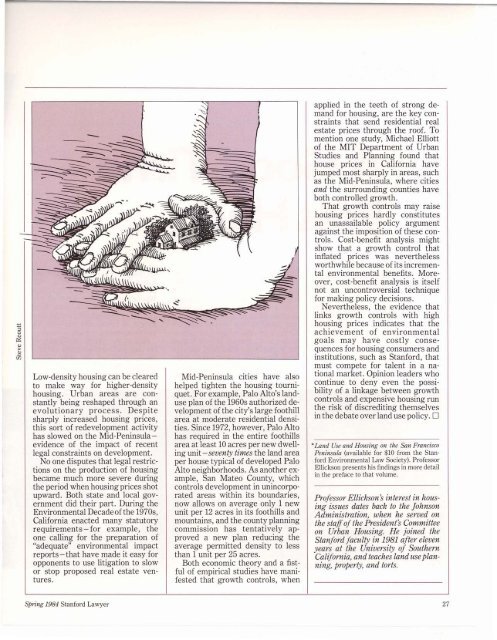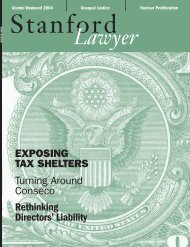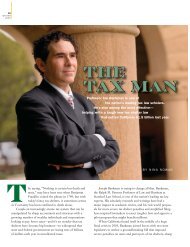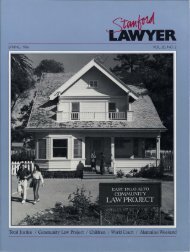Spring 1984 – Issue 31 - Stanford Lawyer - Stanford University
Spring 1984 – Issue 31 - Stanford Lawyer - Stanford University
Spring 1984 – Issue 31 - Stanford Lawyer - Stanford University
- No tags were found...
Create successful ePaper yourself
Turn your PDF publications into a flip-book with our unique Google optimized e-Paper software.
Low-density housing can be clearedto make way for higher-densityhousing. Urban areas are constantlybeing reshaped through anevolutionary process. Despitesharply increased housing prices,this sort of redevelopment activityhas slowed on the Mid-Peninsulaevidenceof the impact of recentlegal constraints on development.No one disputes that legal restrictionson the production of housingbecame much more severe duringthe period when housing prices shotupward. Both state and local governmentdid their part. During theEnvironmental Decadeof the 1970s,California enacted many statutoryrequirements-for example, theone calling for the preparation of"adequate" environmental impactreports-that have made it easy foropponents to use litigation to slowor stop proposed real estate ventures.Mid-Peninsula cities have alsohelped tighten the housing tourniquet.For example, Palo Alto's landuseplan of the 1960s authorized developmentof the city's large foothillarea at moderate residential densities.Since 1972, however, Palo Altohas required in the entire foothillsarea at least 10 acres per new dwellingunit - seventy times the land areaper house typical of developed PaloAlto neighborhoods. As another example,San Mateo County, whichcontrols development in unincorporatedareas within its boundaries,now allows on average only 1 newunit per 12 acres in its foothills andmountains, and the county planningcommission has tentatively approveda new plan reducing theaverage permitted density to lessthan 1 unit per 25 acres.Both economic theory and a fistfulof empirical studies have manifestedthat growth controls, whenapplied in the teeth of strong demandfor housing, are the key constraintsthat send residential realestate prices through the roof. Tomention one study, Michael Elliottof the MIT Department of UrbanStudies and Planning found thathouse prices in California havejumped most sharply in areas, suchas the Mid-Peninsula, where citiesand the surrounding counties haveboth controlled growth.That growth controls may raisehousing prices hardly constitutesan unassailable policy argumentagainst the imposition of these controls.Cost-benefit analysis mightshow that a growth control thatinflated prices was neverthelessworthwhile because of its incrementalenvironmental benefits. Moreover,cost-benefit analysis is itselfnot an uncontroversial techniquefor making policy decisions.Nevertheless, the evidence thatlinks growth controls with highhousing prices indicates that theachievement of environmentalgoals may have costly consequencesfor housing consumers andinstitutions; such as <strong>Stanford</strong>, thatmust compete for talent in a nationalmarket. Opinion leaders whocontinue to deny even the possibilityof a linkage between growthcontrols and expensive housing runthe risk of discrediting themselvesin the debate over land use policy. D*Land Use and Housing on the San FranciscoPeninsula (available for $10 from the <strong>Stanford</strong>Environmental Law Society). ProfessorEllickson presents his findings in more detailin the preface to that volume.Professor Ellicksonsinterest in housingissues dates back to the JohnsonAdministration, when he served onthe staffofthe Presidents Committeeon Urban Housing. He joined the<strong>Stanford</strong> faculty in 1981 after elevenyears at the <strong>University</strong> of SouthernCalifornia, and teaches land use planning,property, and torts.<strong>Spring</strong> <strong>1984</strong> <strong>Stanford</strong> <strong>Lawyer</strong>27
















